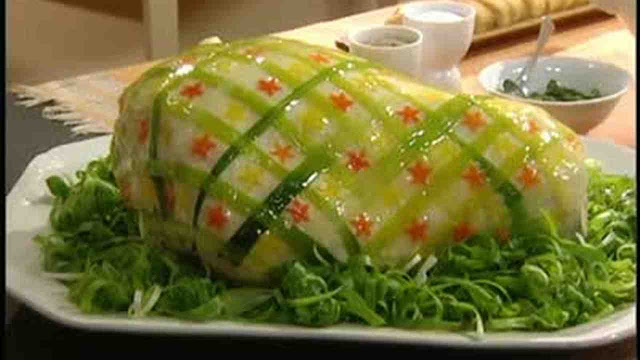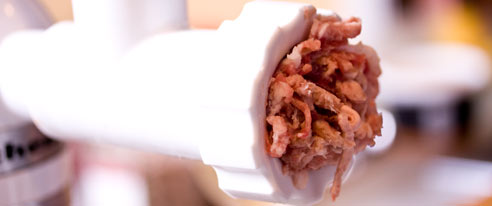Chaud-froid
Chaud-froid
Chaud-froid (pronounced "show-FRWAH") is a word that has two meanings in the culinary arts. Originally, it referred to a dish of cooked chicken which was then cooled and bathed in a jellied sauce made from its cooking liquid.
Today, the word chaud-froid is mostly used to describe the sauce itself, which is a simple enough preparation that involves adding gelatin to a velouté sauce (a sauce made from a base of chicken stock thickened with roux) and is mostly used for decorating serving platters. That jellied chicken dish from which the sauce gets its name is so much more interesting.
First of all, chaud-froid is a French term that translates literally to "hot-cold." The reason for this curiously contradictory name is obscured by the fog of the culinary origin story, examples of which tend to represent either the "fortuitous mistake" genre or the "demanding master" genre. This latter often includes the element of surprise as well (i.e. a gang of nobles comes crashing into the kitchen after hours and demands food).
Chaud-froid's origin story is of the second type. It features the Duke of Piney-Luxembourg, who, while in the midst of hosting a lavish banquet at his castle, finds himself called away by the king. Upon returning home, the hungry duke finds that all that remains of the feast is a plate of cold chicken, which he nevertheless devours, enjoying it so thoroughly that he later he asks his chef to reproduce it exactly as it was. The name chaud-froid thus expresses the paradox inherent in deliberately creating a dish to taste like leftovers.
As culinary origin stories go, this is one of the more believable ones. Anyone who has ever come home hungry and nommed leftover cold chicken straight from the fridge will recognize themselves in old Piney. The difference between him and you is that he can go to his chef the next day and order him to replicate it, right down to the jiggly bits of jelly that, let's face it, are what make leftover cold chicken so heavenly.
This being the era of the Ancien Régime, not exactly known for its restraint in pursuit of personal pleasures (culinary or otherwise), the chef outdid himself, serving the chaud-froid on a three-tiered edible pedestal, decorated with truffles, lark tongues and other delicacies, and crowned by a coxcomb (which if you're not familiar, is that red floppy thing that resides on the top of a rooster's head). And thus was born a legend.
By contrast, these days the term chaud-froid almost always refers to a jellied sauce that is used to decorate serving platters or to coat chicken breasts or other cooked and cooled items (usually poultry). As mentioned earlier, it's typically made by adding gelatin to a velouté sauce, or a demi-glaze or a béchamel sauce.
It can also be made by adding cream to a simple aspic. In a pinch, it's possible to add gelatin to mayonnaise or sour cream, to make a chaud-froid substitute called a mayonnaise collée.
Classification of Chaud-froid:
Classic Chaud-froid: Basic veloute + Aspic + Fortified with aspic jelly + cream.
Contemporary Chaud-froid: Those sauces which doesn’t have base as starch. It is reduced stock, lightened with cream. Starch: refined flour.
Stock should have high gelatin content.
· Pink Chaudfroid/Basic Chaudfroid: Mixed with tomato puree.
Aurore sauce (veloute + tomato) + addition of cream.
· Green Chaudfroid: Spinach puree + Cream to neutralize the colour.
· Brown Chaudfroid: Made from Demiglaze = Aspic with addition of sherry/Madeira. Cream should be avoided as it will lighter the colour.
Cold platter meats when exposed to air, dries out and the colour changes and outer crust gets hard and gives dull appearance.
- It adds smoothness ad enhances the eye-appeal.
- It compliments to the flavour of the coated item.
Guidelines while using Chaud-froid:
- Whatever product to which chaud-froid is to be applied, should be free from any fat (wash with warm water). Fat will not allow to stick and it wil fall.
- The item should be absoultely dry (use duster or cheese cloth).
- Take tempered chaud-froid and apply.
- item should cold not hot (it will not stick and run down).






Comments
Post a Comment